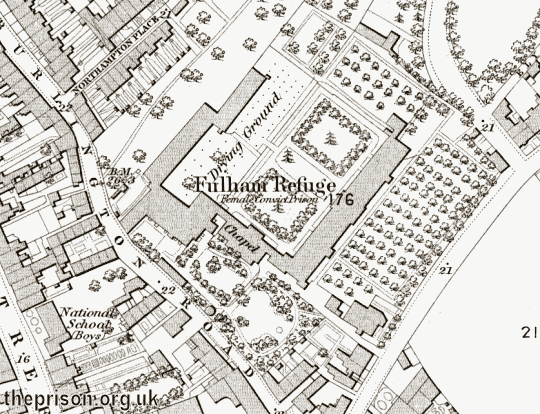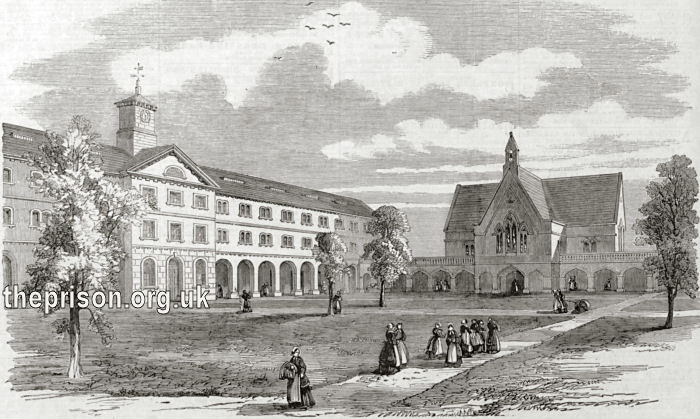Female Refuge/Reformatory, Fulham, London
In 1856, a prison for female convicts was opened on Burlington Lane (now Burlington Road), Fulham. Initially known as the Fulham Refuge or the Fulham Reformatory, it was intended to receive female convicts during the last twelve or fifteen months of their sentences of penal servitude, and provide training for future employment in skills such as cooking, cleaning and laundry, with and emphasis on "softening and civilising". The labelling of the prison as a 'Refuge' — a term then also used to describe establishments receiving young women who were considered in moral danger — was intended to make potential employers less reluctant to employ it former inmates.
According to a contemporary report:
The establishment consists of a large old mansion and certain new buildings buildings. The former has been converted into offices, stores, &c., as far as was required, and into dormitories for about forty of the female prisoners.
The buildings, however, most deserving of attention are those which have been added — namely, the chapel, a new wing containing the small separate sleeping-places, and a laundry, all connected together by an arched corridor, and each conveniently adapted for its purpose. The main building contains on the ground floor four large rooms, two of which are workrooms, a third is for school purposes, and the fourth is for taking meals, &c. The centre is occupied by stairs and offices; and the dormitories, which are on the first floor, are ranged in two stages or stories on each side of a corridor, the upper ones opening on galleries. The sleeping-places, divided by corrugated iron partitions and open railings, are 9 feet long by 5 feet 6 inches broad, each with a small window and a flue for ventilation. They contain a bed, washing-stand, table and stool, shelves, pegs, &c.
These buildings two disposed round three sides of a square, a portion of which is divided off by iron railings as a drying-ground, the remainder being laid down in grass and gravel for exercise. Tho inmates, amounting to about 180, are, as already explained, sentenced to long terms of confinement, few being for less than four or five years ; and the discipline under which they are brought is the last of the progressive stages applicable to female convicts under such sentences.
Varied and continuous industrial employment, combined with religious, moral, and school instruction, and great liberty of action, are the leading features of the discipline, rising at a quarter before six and going to bed at nine. The daily routine comprises prayers morning sad evening of about hall-an-hour's duration, washing, laundry-work, cooking, baking, house and media work, employment in the garden and grounds, &c. A proportion of the women are at school or under the Scripture-reader daily , and during the evening, when all have the privilege of working for themselves, the matrons road to them.
We learn that 173 prisoners have been discharged since the first was liberated in August, 1858, the establishment having been opened on the 8th of May preceding. To those who are practically acquainted with the class of women under consideration, and are aware of the difficulties with which they are surrounded on discharge, liable as they are to meet the scorn of the world on the one hand and its still more dangerous allurements on the other, it will be a matter of astonishment that so many are doing well, either with their own families, or in service, or otherwise gaining an honest livelihood.
The following is the carefully-digested account of the Chaplain in reference to them up to the present time:— Total discharged, 173; of whom 129 on expiration of sentence, 41 on licence, 2 on free pardon, 1 on medical grounds. Of these, during the period of two years and a quarter, there have been reconvicted, 1 ; awaiting trial, 1; licences revoked, 3; unfavourable accounts received, 14; doubtful cases, about one-half of which may be reckoned favourable, 35; favourable cases recommended to, and taken in hand by, the discharged prisoners and society, 25; good reports received as decidedly hopeful cases, 92; have died since discharged, 2.
The prison site is shown on the 1865 map below.

Female Refuge/Reformatory site, Fulham, c.1865.

Female Refuge/Reformatory, Fulham, London, 1858.
In 1870-71, with a hardening of attitudes towards the treatment of convicts, the prison was enlarged to about 400 places and renamed Fulham Female Convict Prison. Following a decline in numbers being placed there, resulted in the prison being closed in 1888, with the remaining inmates were transferred to Woking Prison. The old mansion was demolished in 1895, and the other buildings were sold for conversion to housing.
Records
Note: many repositories impose a closure period of up to 100 years for records identifying individuals. Before travelling a long distance, always check that the records you want to consult will be available.
- The National Archives, Kew, Richmond, Surrey, TW9 4DU. Has a wide variety of crime and prison records going back to the 1770s, including calendars of prisoners, prison registers and criminal registers.
- Find My Past has digitized many of the National Archives' prison records, including prisoner-of-war records, plus a variety of local records including Manchester, York and Plymouth. More information.
- Prison-related records on
Ancestry UK
include Prison Commission Records, 1770-1951
, and local records from London, Swansea, Gloucesterhire and West Yorkshire. More information.
- The Genealogist also has a number of National Archives' prison records. More information.
Census
Bibliography
- Higginbotham, Peter The Prison Cookbook: A History of the English Prison and its Food (2010, The History Press)
- Brodie, A. Behind Bars - The Hidden Architecture of England's Prisons (2000, English Heritage)
- Brodie, A., Croom, J. & Davies, J.O. English Prisons: An Architectural History (2002, English Heritage)
- Harding, C., Hines, B., Ireland, R., Rawlings, P. Imprisonment in England and Wales (1985, Croom Helm)
- McConville, Sean A History of English Prison Administration: Volume I 1750-1877 (1981, Routledge & Kegan Paul)
- Morris, N. and Rothman, D.G. (eds.) The Oxfod History of the Prison (1997, OUP)
- Pugh R.B. Imprisonment in Medieval England (1968, CUP)
Links
- Prison Oracle - resources those involved in present-day UK prisons.
- GOV.UK - UK Government's information on sentencing, probation and support for families.
Except where indicated, this page () © Peter Higginbotham. Contents may not be reproduced without permission.



